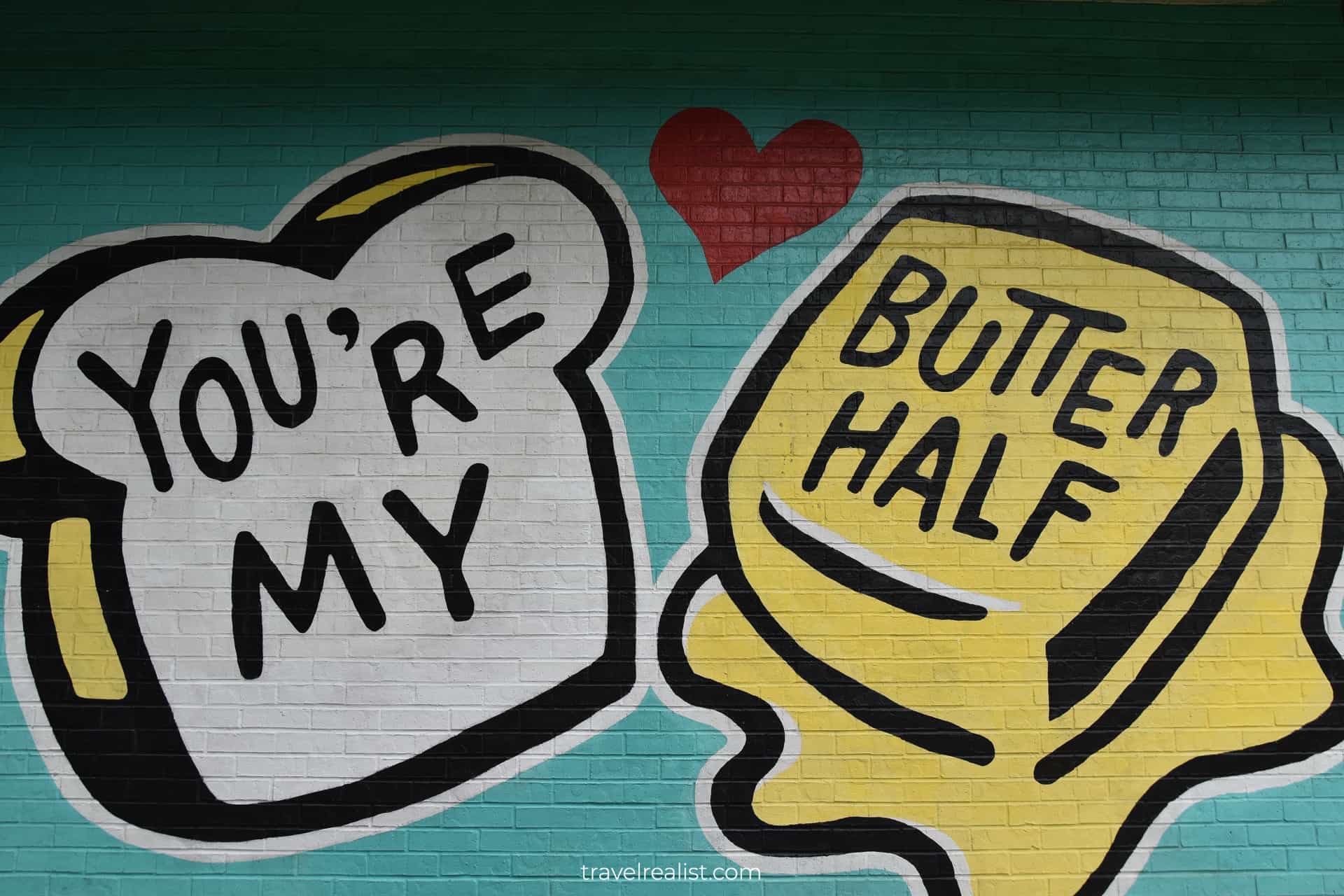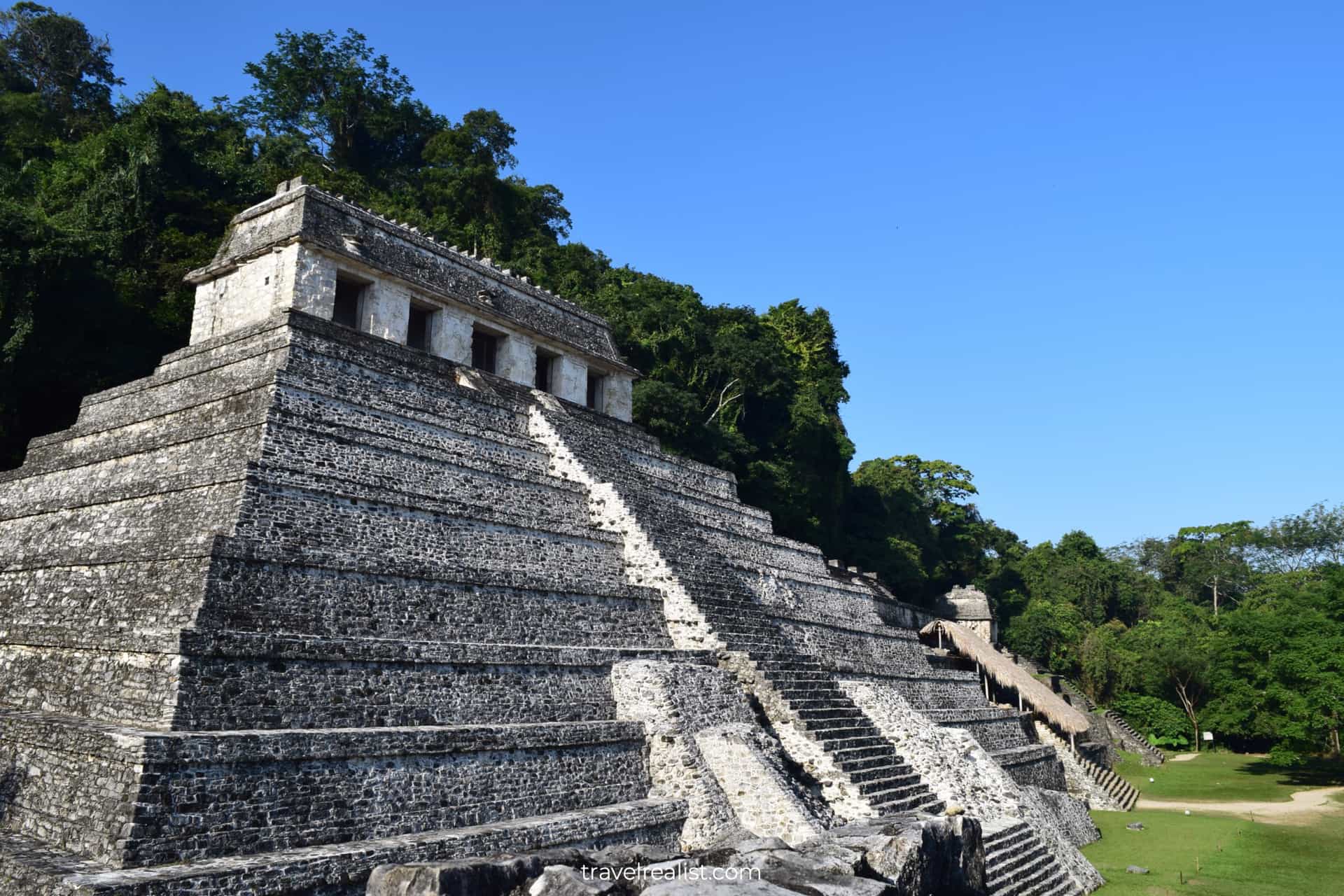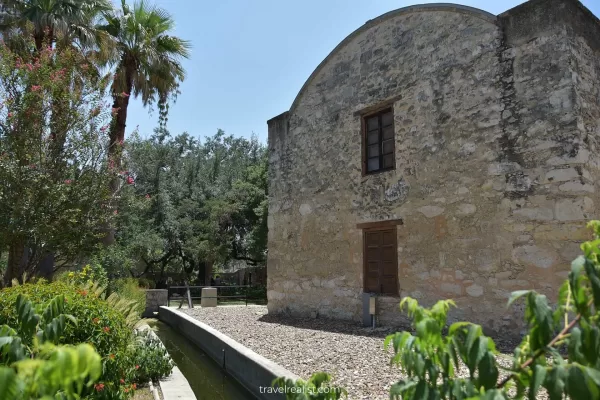Death Valley: 11 Stops Near America’s Lowest Point
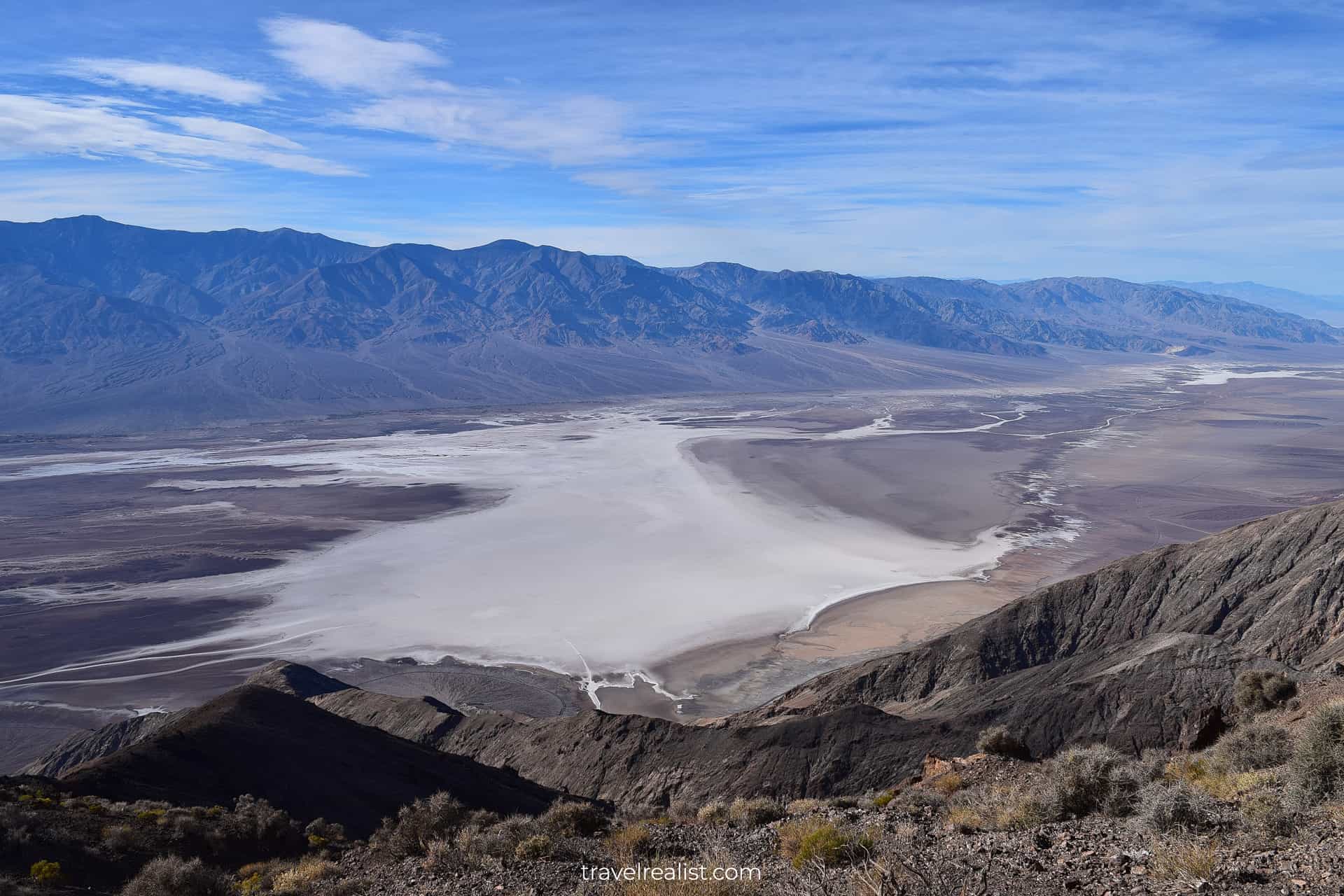
This realistic Death Valley National Park Guide helps you plan your next adventure in this park.
Death Valley National Park protects Badwater Basin, the lowest point in North America.
This post includes affiliate links that will earn us commission if you make a purchase via these links.
Sights & Places of Interest
The location of Death Valley National Park is responsible for its name. It comes from the grueling summer temperatures the park visitors have to endure. They often exceed 120°F (48.9 °C).
Death Valley has a few notable sights. They range from geological formations and sand dunes to salt creeks and historic structures.
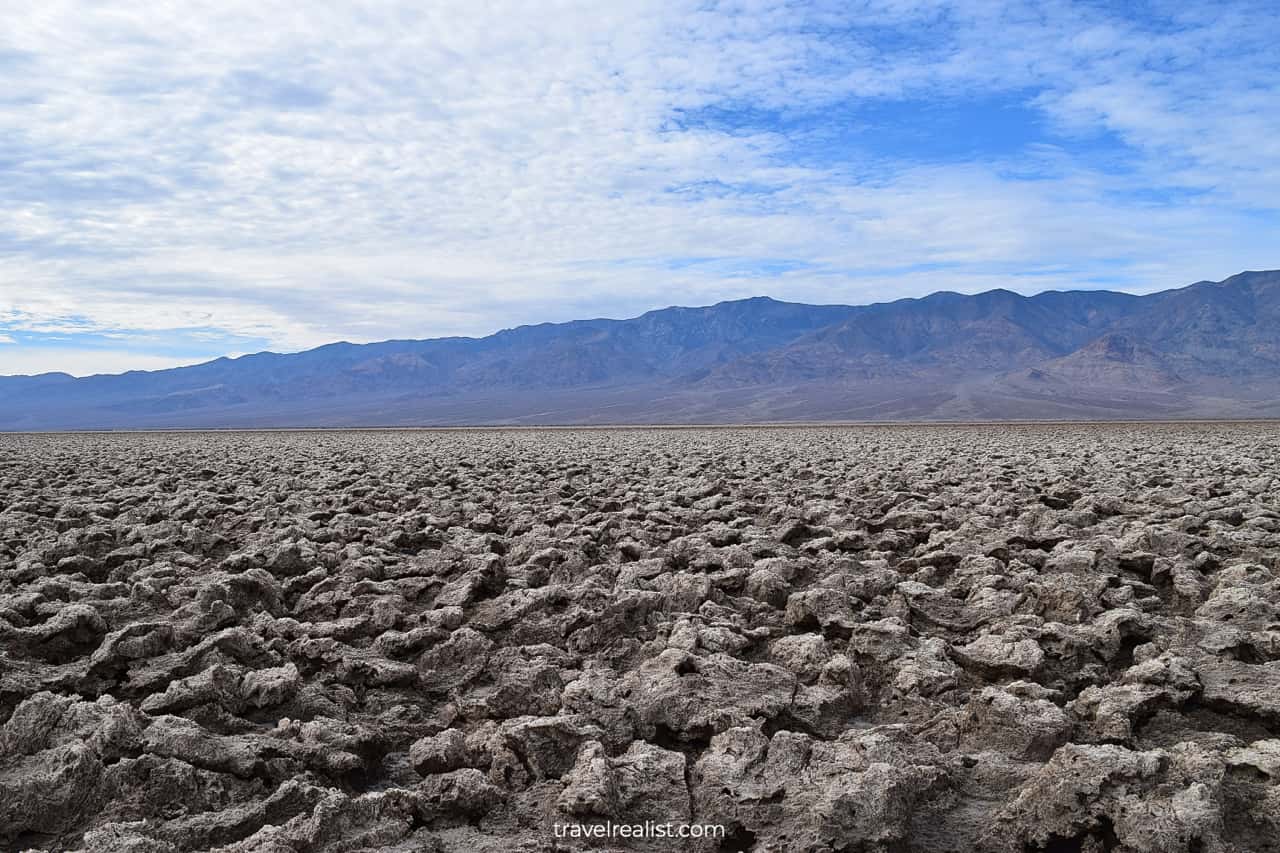
There are five paved roads leading into the park. Regardless of the road you choose, take a notice of the markers along the way.
These markers show the current altitude relative to the sea level. They help you locate the sections of Death Valley that are below the sea level.
Low altitude, harsh climate, and evil name might give you the wrong impression of this park. You will see far less wildlife in Death Valley than in Rocky Mountain. But this park is also full of life.
Be on the lookout for coyotes. These predators are present all around the valley. But they often prefer areas that do not get a lot of visitors. A drive between Ashford Mill and Badwater fits this description.
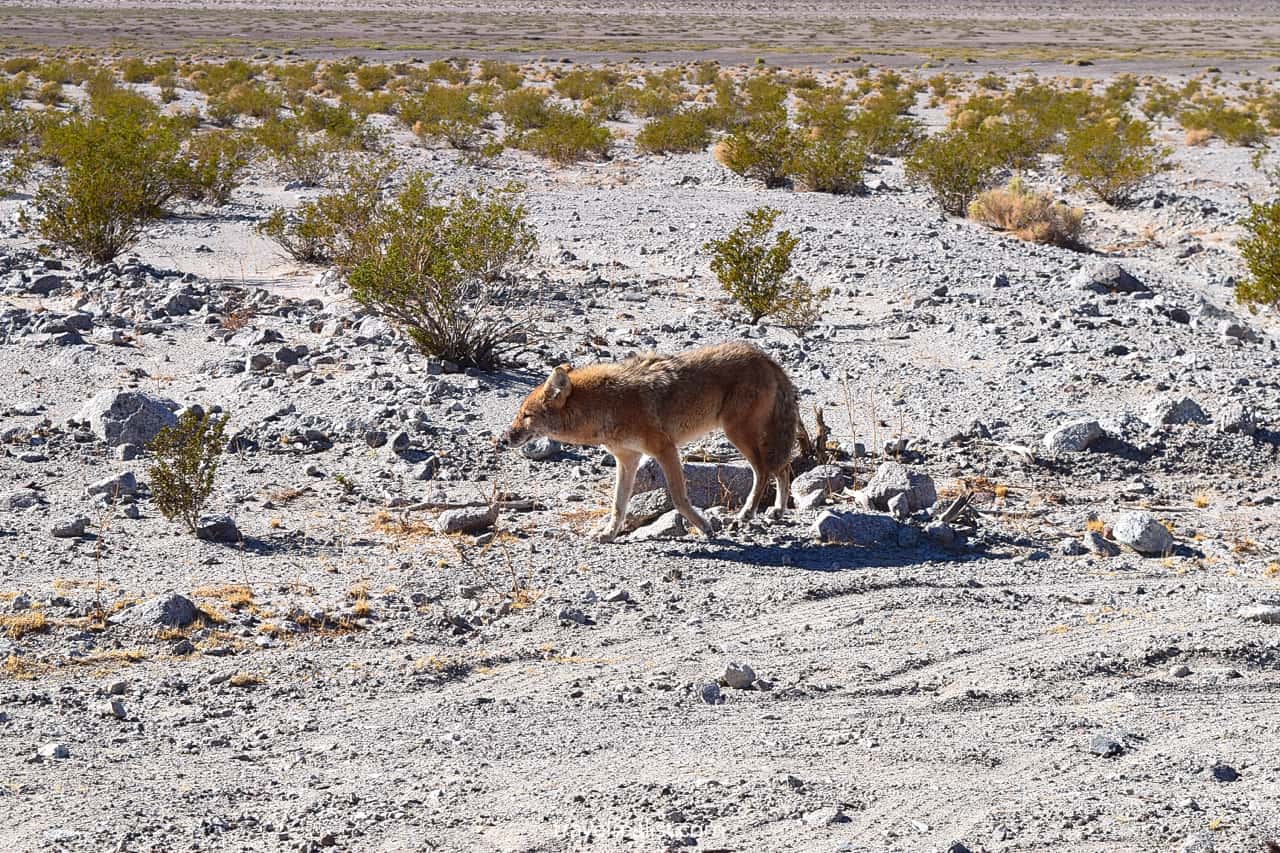
This Death Valley National Park Guide will focus on the stops you should not miss in the park.
1. Badwater Basin
The Badwater Road has few sights if you travel from Shoshone. In fact, the spooky names, like Funeral Peak, are the only things to keep you entertained during this drive.
But things will change quickly as soon as you arrive at the Badwater Overlook. It is one of the major sights in the park.
Badwater Basin is the lowest point in North America. The Basin is at 282 ft (86 m) below the sea level.

White salt covers a large area of the Basin. You can walk on this salty slippery surface. But do so carefully and at your own risk. Exercise a little extra caution when hiking in Badwater Basin.
As you hike you will see puddles of salt water. They are prefect for capturing reflections. You can see the Amargosa Range that surrounds Badwater Basin.
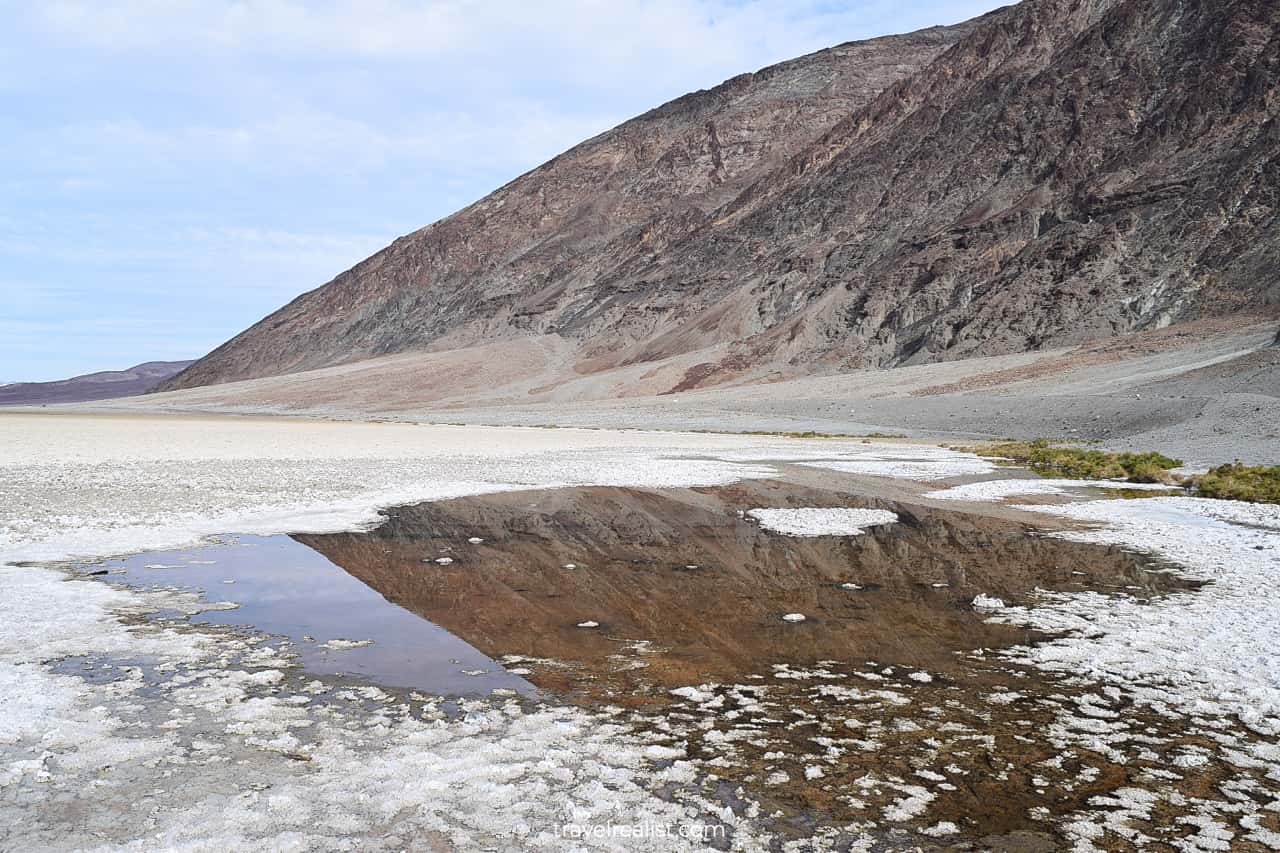
2. Natural Bridge
There are a lot of sights in the park as soon as you pass Badwater. Keep in mind that you would need to turn from the main road every few miles (kilometers). Some of the side roads are unpaved.
Budget extra time if you choose to explore all of these sights. If time is an issue, pick just a handful of areas to explore.
You would not want to skip the Natural Bridge. It is a natural arch than looks little like the formations in Arches National Park.
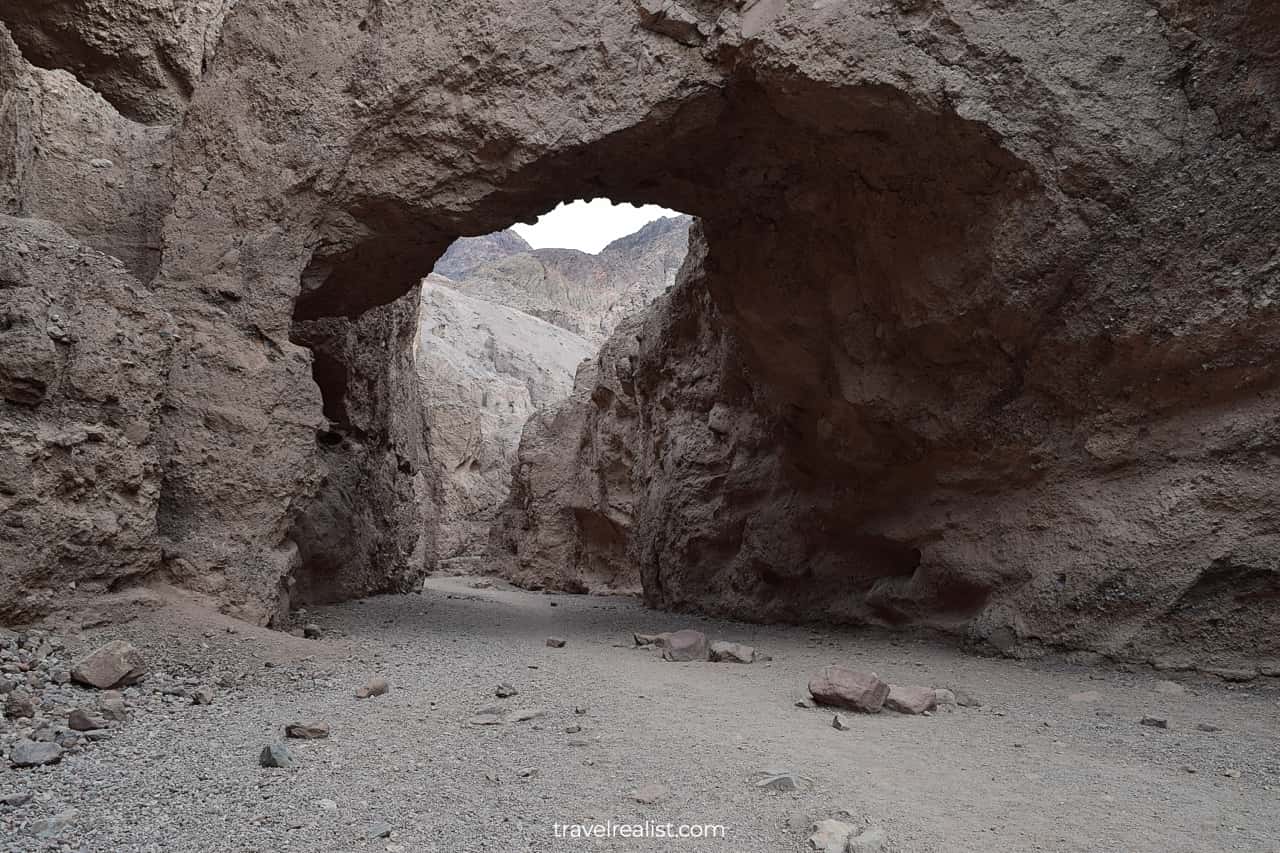
- The Natural Bridge is the closest attraction to Badwater.
- You can reach the trailhead in about 5 minutes from Badwater Basin.
- You would need to hike to see this arch.
- There is a short and easy 1-mi (1.6-km) out-and-back hiking trail.
- An elevation gain is 449 ft (137 m).
This Natural Bridge pales in comparison to other Arches across the Southwest. But it is part of a narrow canyon. This setup gives the Natural Bridge a unique charm.
The return leg of the hike is also quite beautiful. You will get a front row seat to the fantastic views of Badwater Basin and Death Valley. You should thank the elevation gain for these views.
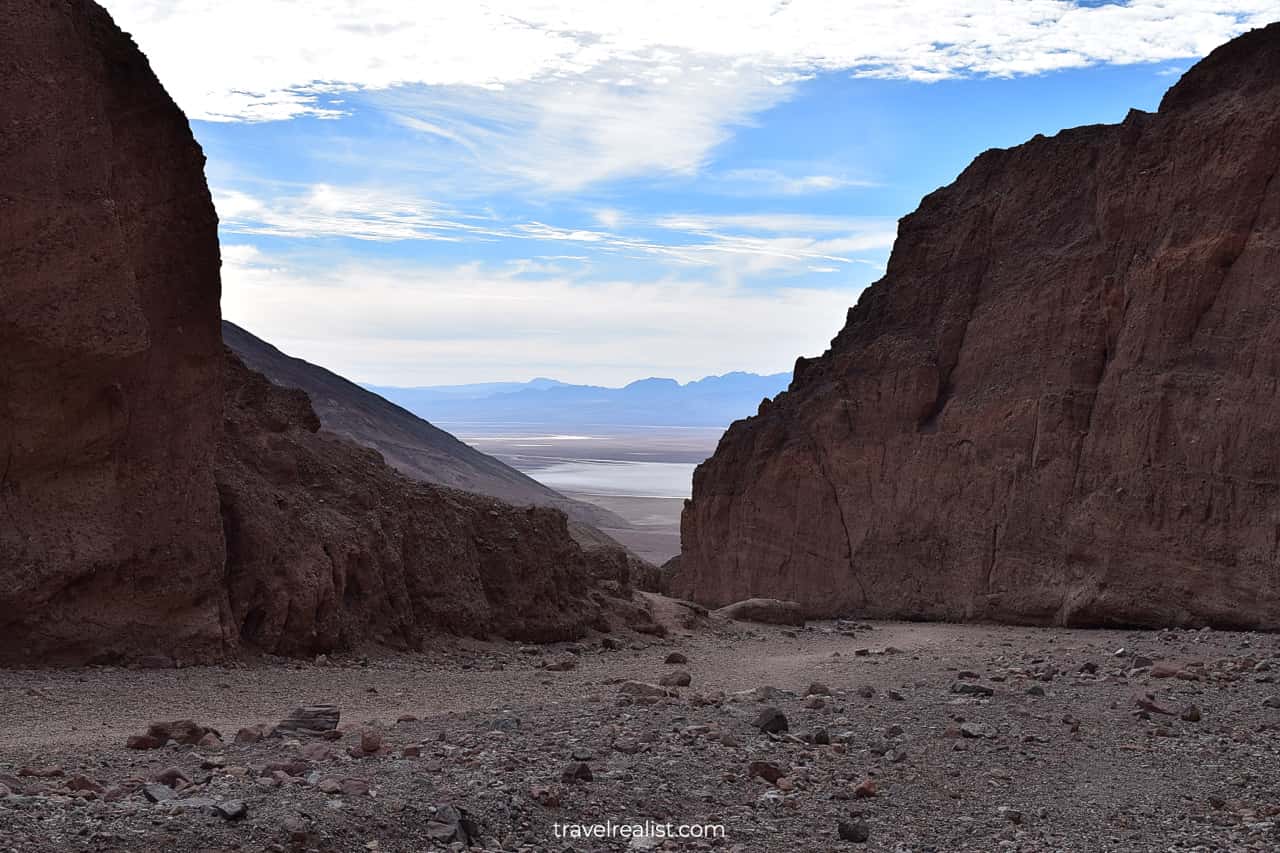
3. Devils Golf Course
The Devils Golf Course is the next must-visit stop in Death Valley National Park. This viewpoint brings you back to the middle of the valley.
You would need to get back on the paved Badwater Road just to exit it minutes later. You would need to drive on an unpaved side road to get to the Devils Golf Course. This fact makes it similar to the Natural Bridge.
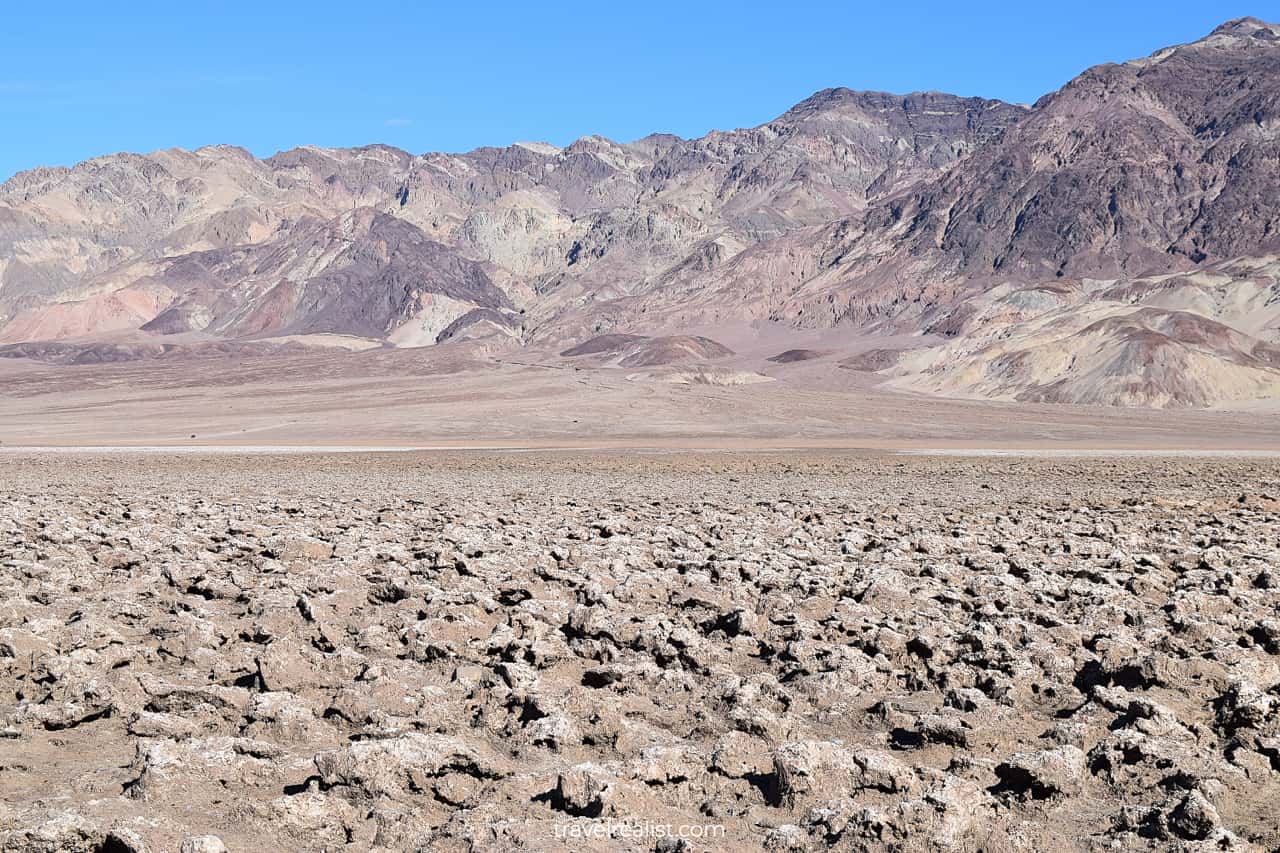
This viewpoint has a moon-like landscape. It attracts visitors looking to walk on the rugged surface. There are no marked trails at the Devils Golf Course. You are free to walk on this terrain.
Just try to be gentle to these formations. Exercise caution since some rocks have sharp sides. They could easily scratch your shoes. Uneven surfaces could also lead to twisted ankles if you are not careful.
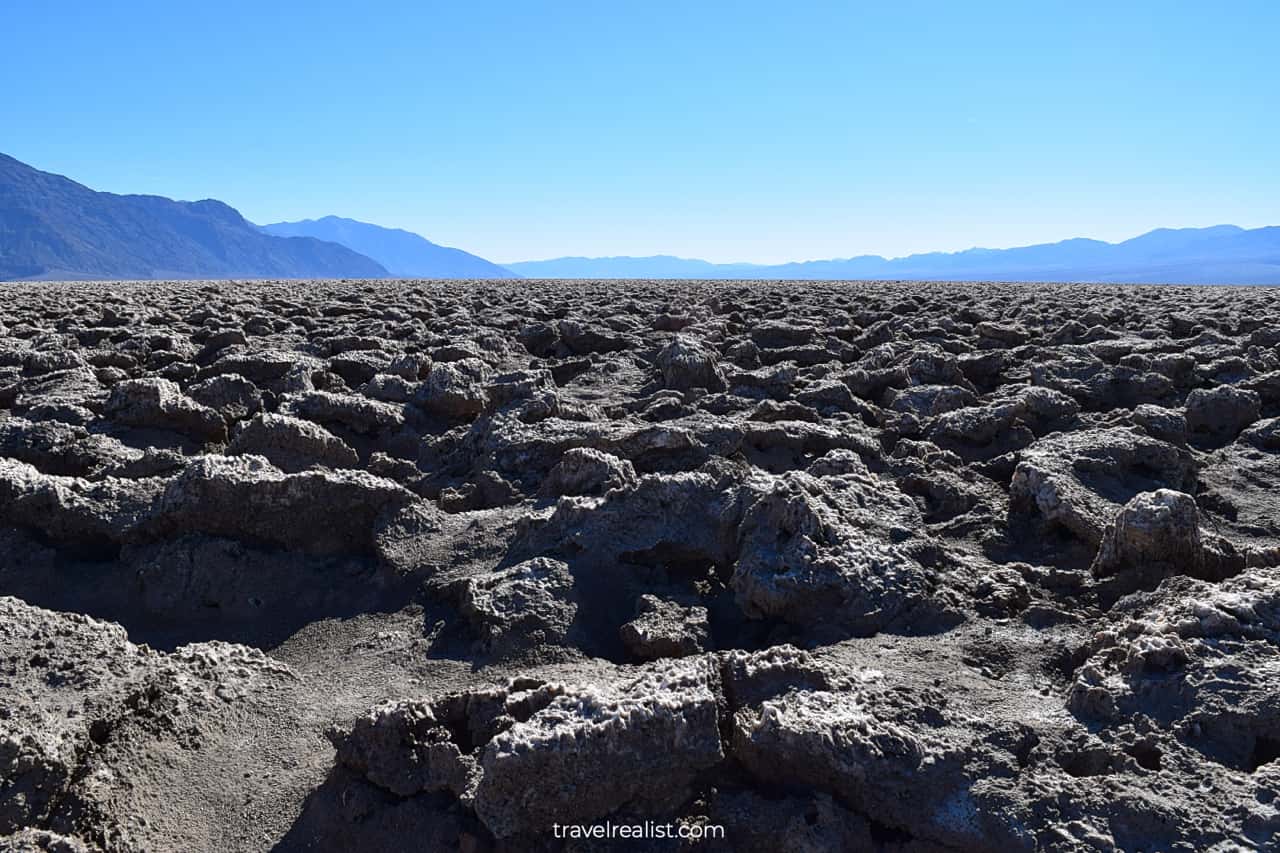
4. Artists Drive
You might start to feel tired of taking the side roads to different formations in the park. But you should not let your feelings get in the way. The next drive is an attraction in itself.
The Artists Drive is a paved one-way drive. You can enjoy 9 miles (14.5 km) of endless beauty. This Drive has lots of colorful formations and a few no-name viewpoints.
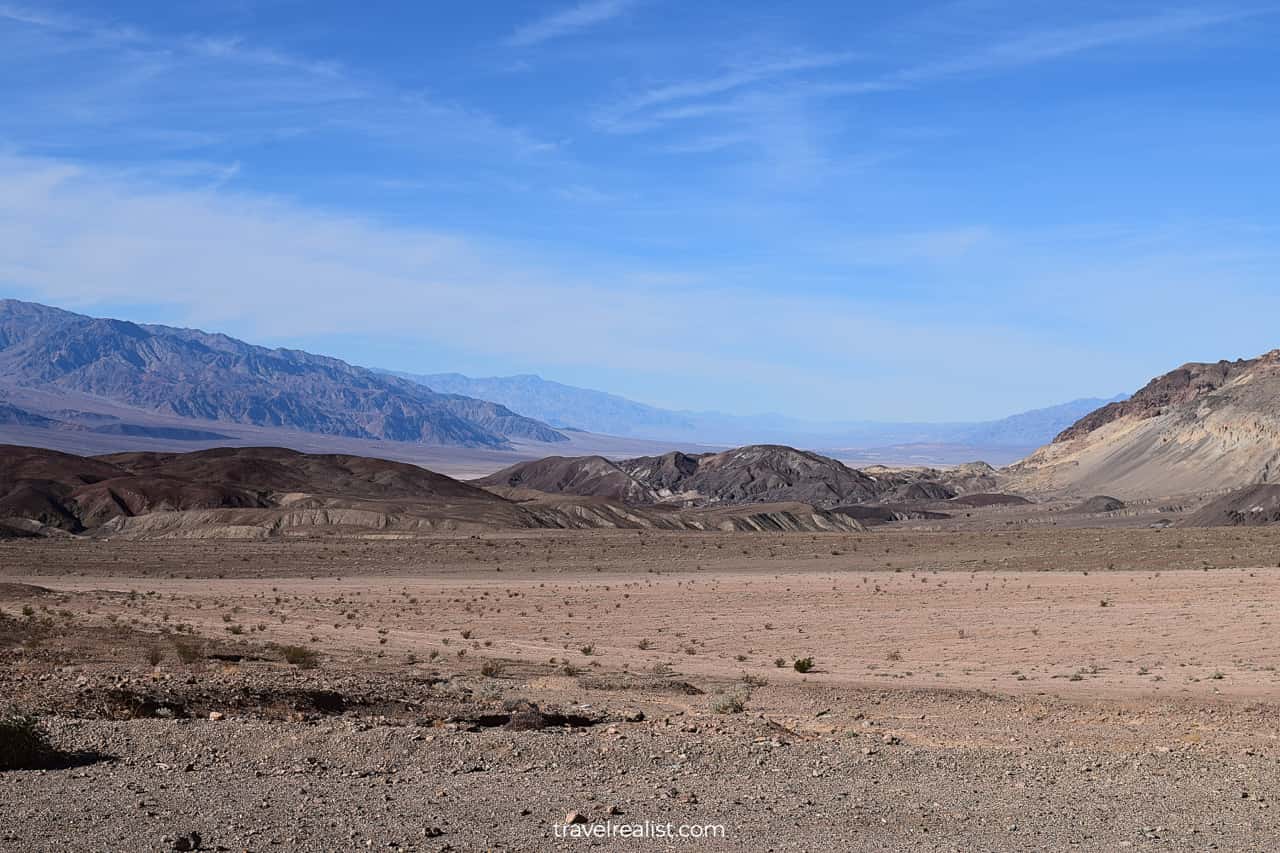
The Artists Drive is one of the most popular sights in the entire park. It is an incredibly picturesque and enjoyable ride.
You can stop at the viewpoints to admire the beauty that surrounds the Drive. Or you could just keep driving. Either way, you will not miss the winding turns along the colorful hills.
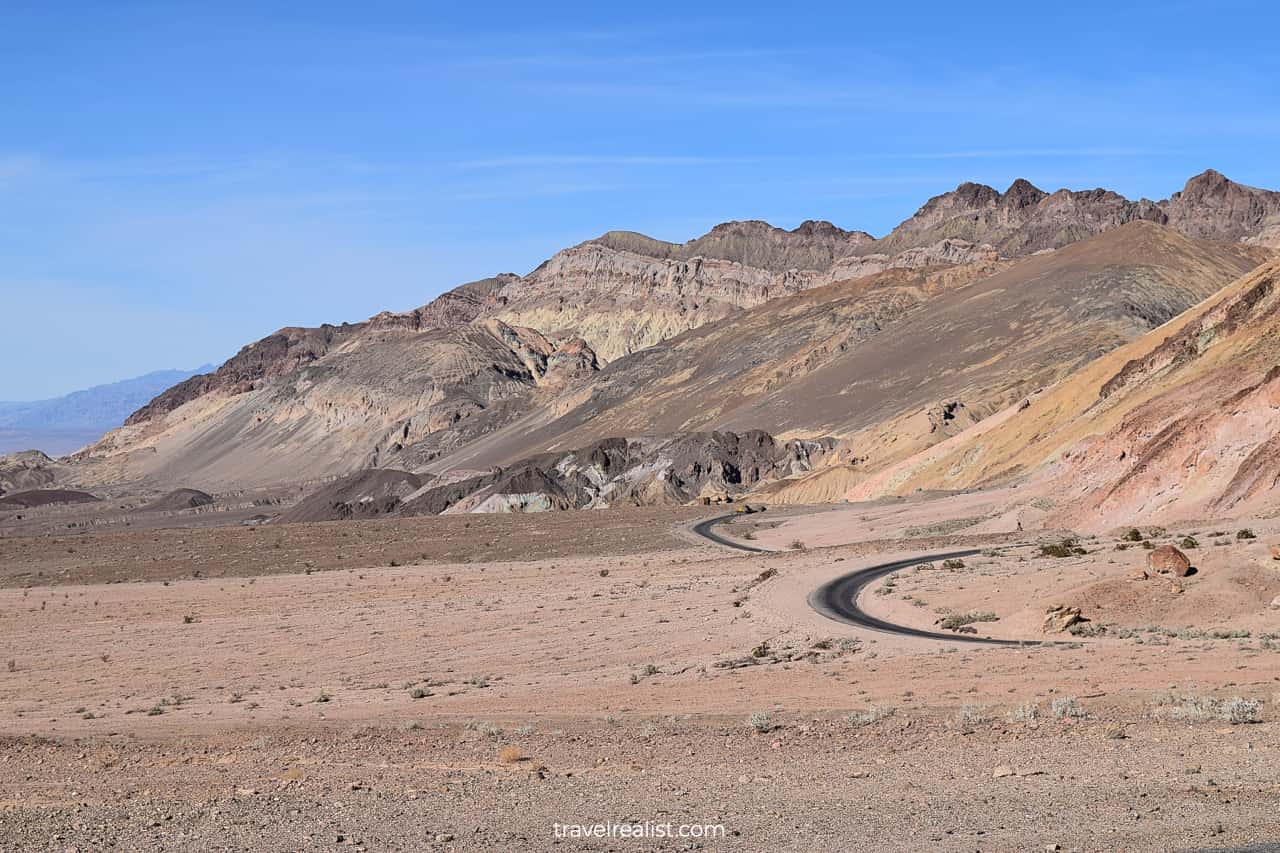
5. Artists Palette
About halfway into the drive, you will reach the Artists Palette viewpoint. It is a crown jewel of the Drive and this Death Valley National Park Guide.
It has extremely vivid colors. In fact, it is easy to see how this viewpoint got its name. The resemblance with a real artists palette is quite remarkable.
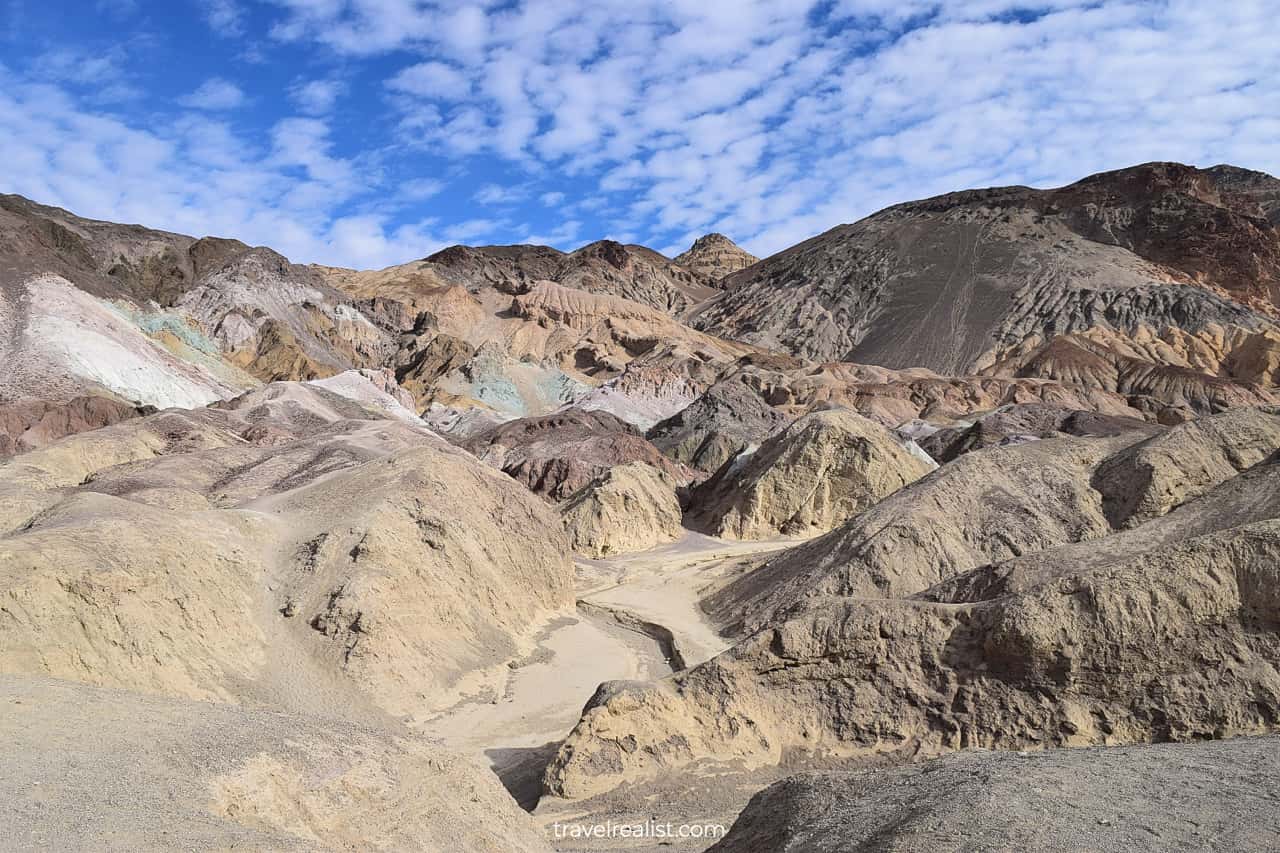
6. Desolation Canyon & Golden Canyon
Once you return to the Badwater Road, you will have a few options. You can once again take a couple of side roads.
- One road will bring you to Desolation Canyon.
- The other road takes you to a larger hiking area. It connects Golden Canyon with Zabriskie Point.
You would need to budget quite some time to explore both stops. Desolation Canyon resembles the Natural Bridge Canyon. And Golden Canyon looks just like canyons in Cathedral Gorge.
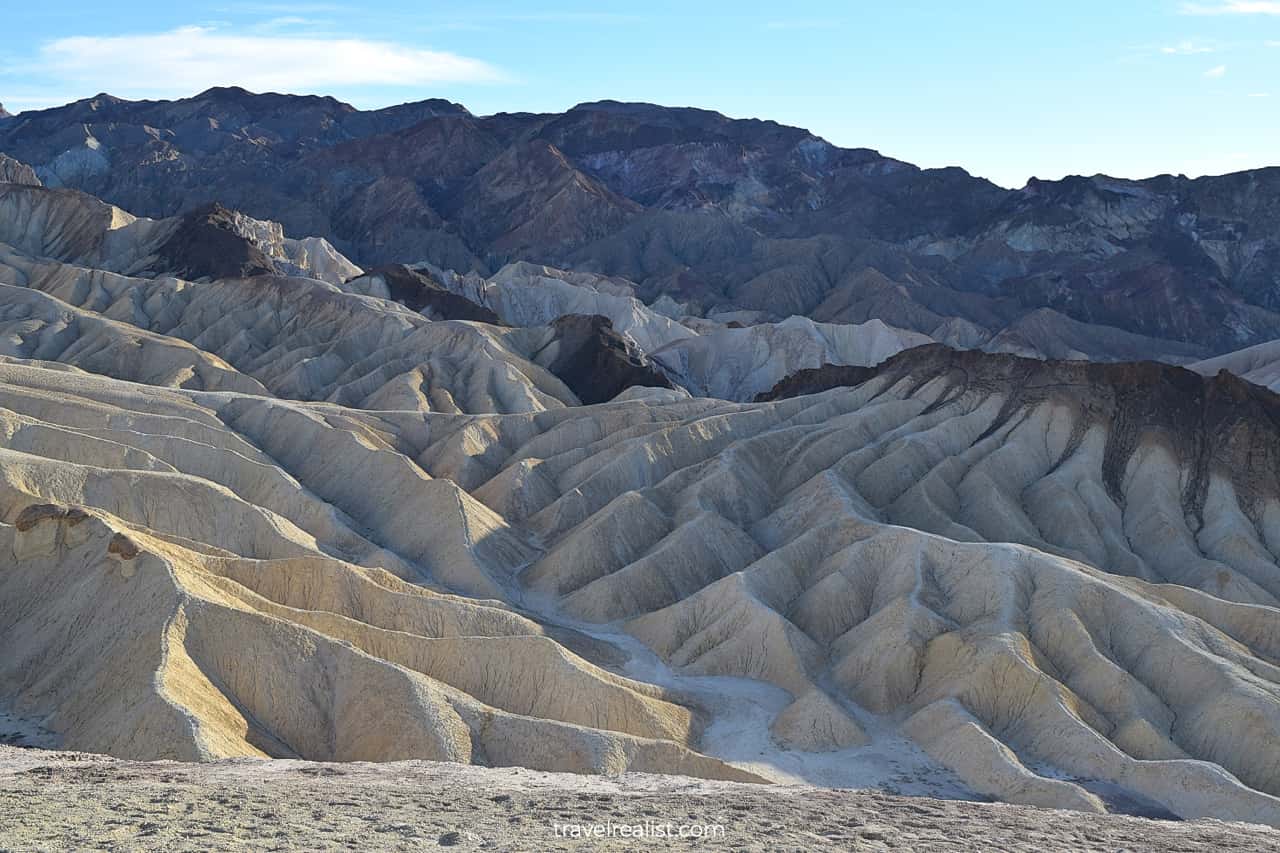
If time presents an issue for your exploration, you can skip these sights. You will get a glimpse of both formations when you visit Zabriskie Point later.
In this case, you can continue to the Furnace Creek Visitor Center. This area has one of the few gas stations in and around the park. Fill up your tank if you have a long road ahead.
7. Mustard Canyon & Harmony Borax Works
Once you pass the Visitor Center, you will be at the next notable stop. The Mustard Canyon Drive is an unpaved side road.
As the name suggests, the yellow colored formations are next to the Drive. The vivid yellow color is the main attraction on this Drive. But it is far from the only one.
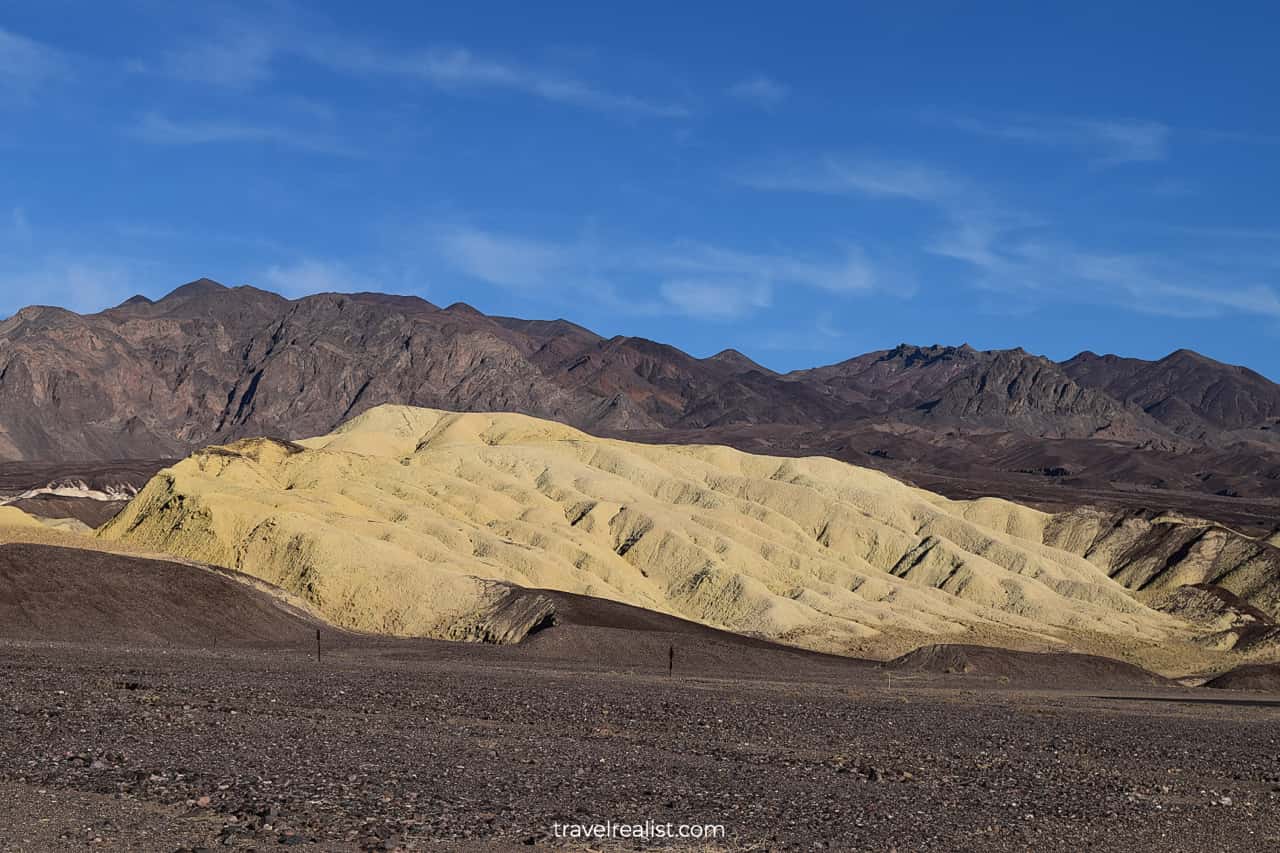
You can take the paved section of the Drive to the Harmony Borax Works. This is one of the historical sights in Death Valley.
This site preserves the remnants of the mining structures. Some of them look somewhat similar to Pueblo houses in Wupatki National Monument. You could also see old carriages up-close.
Kids and history lovers would get the most value from this stop. Keep in mind that there is no shade on this loop walk around the Harmony Borax Works.
8. Salt Creek
There will be no sights for a while as you continue driving north on State Highway CA-190. Once you pass Beatty Junction, you will have an option to turn left on another unpaved road into the valley.
If you take it, you will arrive at the Salt Creek Interpretive Trail. The name of this stop says its all. It is an accessible boardwalk along the Salt Creek. There are a handful of information exhibits along the way.
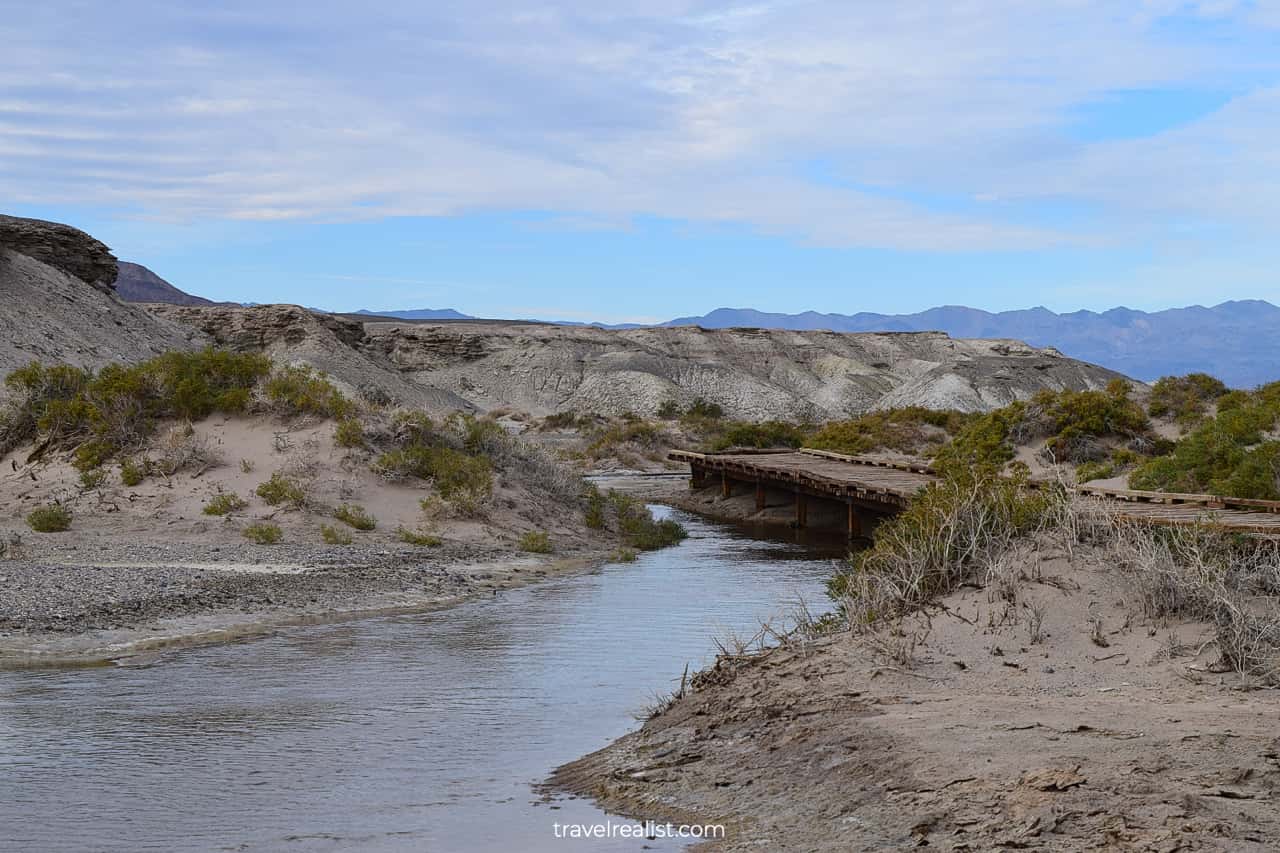
It takes less than 30 minutes to walk this 0.5-mi (0.8-km) trail. The views do not change much throughout the trail. You can get a good feel for this stop right at the parking lot.
The sunset is the best time to visit the Salt Creek. You can get fantastic views and reflections then.
This area of the park suffered damage during the 2022 flooding. The boardwalk was washed away. The park rangers are working diligently to restore it. But this area remains closed until at least fall 2023.
9. Mesquite Flat Sand Dunes
Mesquite Flat Sand Dunes is an obvious next stop in Death Valley National Park.
- The Dunes could be your first attraction in the park if you travel from Los Angeles.
- Or they could be the furthest point of your trip to Death Valley if start from Las Vegas.
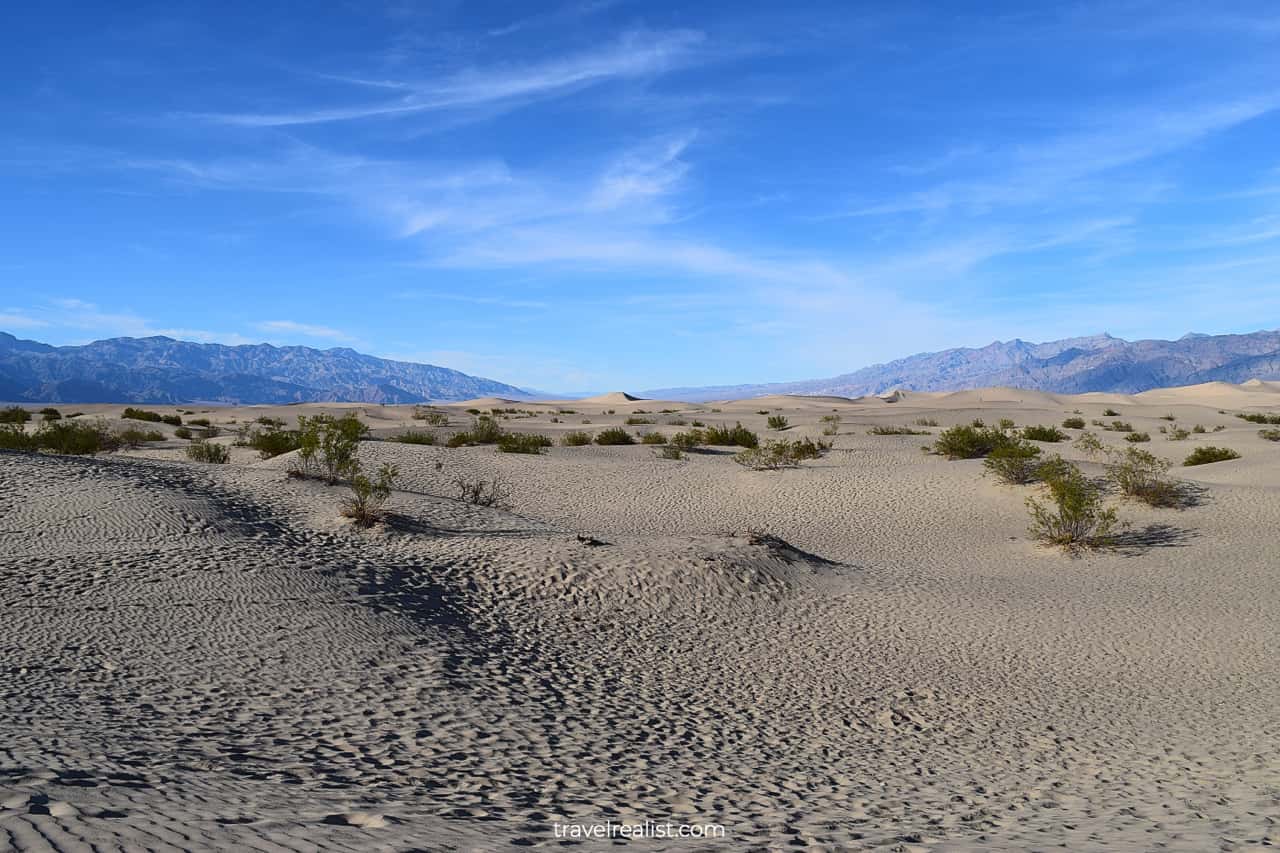
Like with the Salt Creek, the name of these dunes gives it all away. The dunes are in Mesquite Flat, near the Death Valley Wash.
This area of the park is very scenic. You can see the dunes with two mountain ranges in the distance. The Cottonwood Mountains are on the west side of the dunes. The Grapevine Mountains are on the east side.
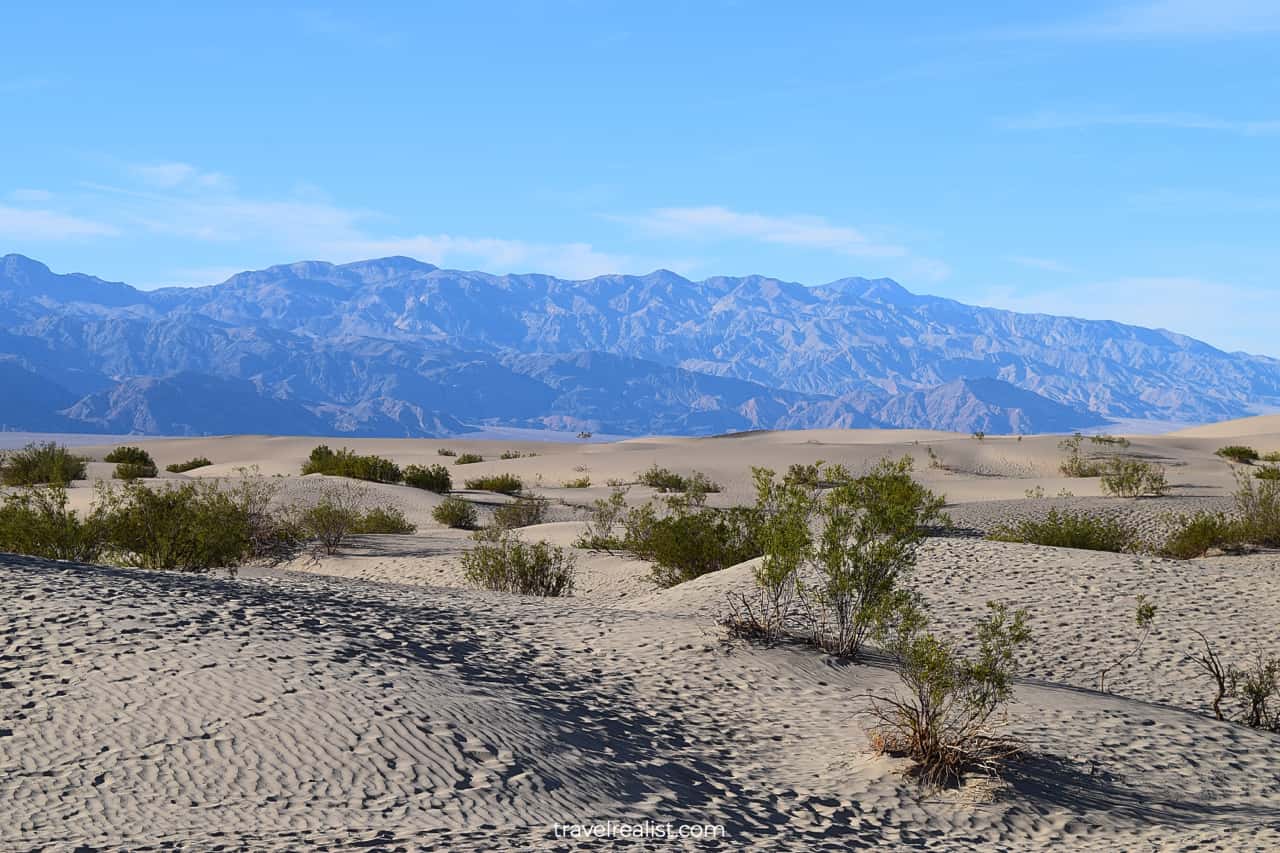
Mesquite Flat Sand Dunes are a lot smaller than sand dunes in other parks. You could explore the dunes in Great Sand Dunes and White Sands National Parks for hours. It will take you less than thirty minutes to get a feel for Mesquite Flat Sand Dunes.
10. Zabriskie Point
Zabriskie Point is another great stop in Death Valley National Park. You would need to drive back for almost 30 minutes if you visit this point after the sand dunes.
In this case, you will pass the points you already visited, like Salt Creek, Mustard Canyon, and Furnace Creek.
But Zabriskie Point could also be one of your first stops in the park. This would be the case if you enter the park from Death Valley Junction.
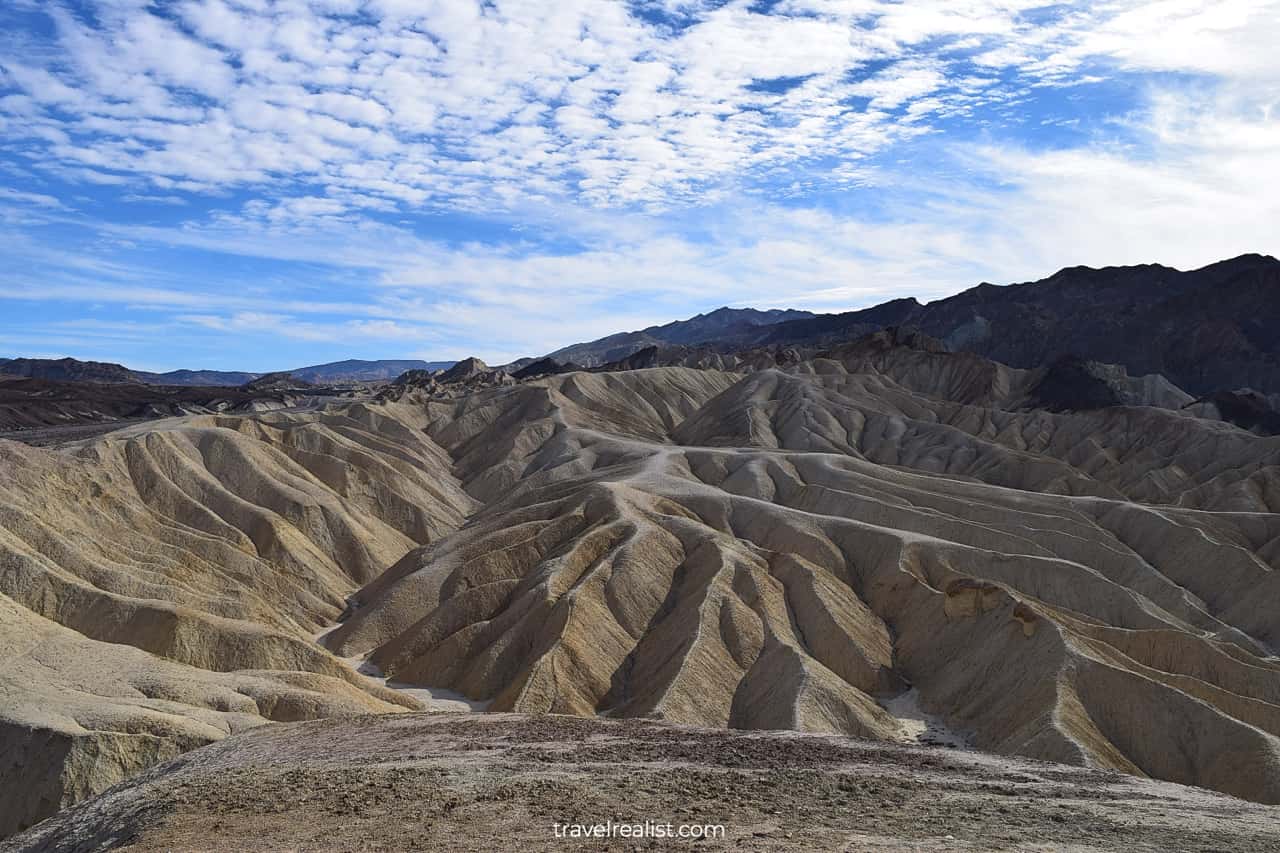
This point has colorful formations. They are similar to the Artists Drive and Golden Canyon. This is hardly a surprise.
- Zabriskie Point is right across the ridge from the Artists Drive.
- You can also reach it on a hiking trail from Golden Canyon.
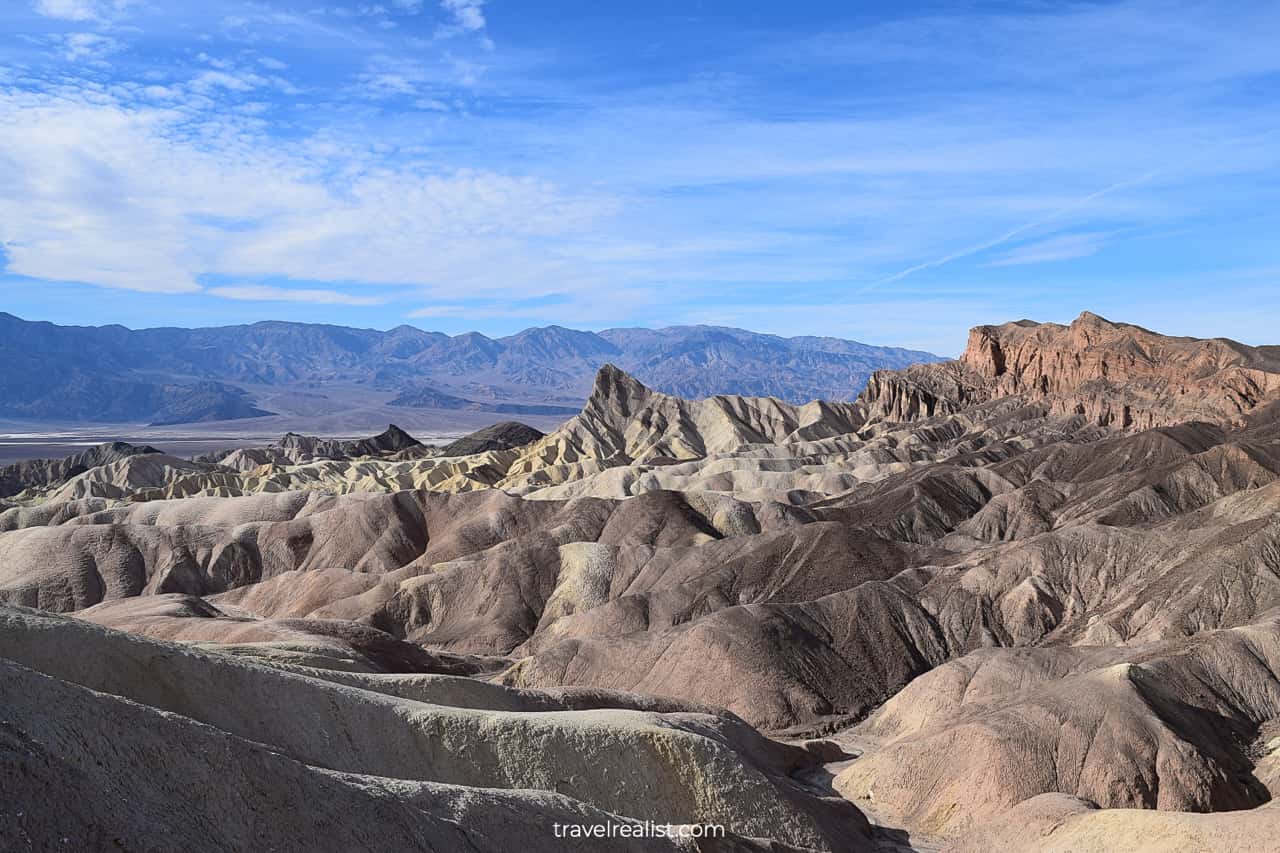
Zabriskie Point is right next to an unpaved Twenty Mule Team Canyon Drive.
11. Dantes View
This Death Valley National Park Guide saved the best for last. You should take an 27-mi (43-km) detour from State Highway CA-190 to Dantes View. Do not even think about skipping this viewpoint.
You will gain 3,550 ft (1,082 m) in elevation as you drive towards this view. It is almost directly above Badwater Basin.
As a result, this point has by far the best views in the park. You can see Badwater Basin and entire Death Valley from a bird’s eye view.
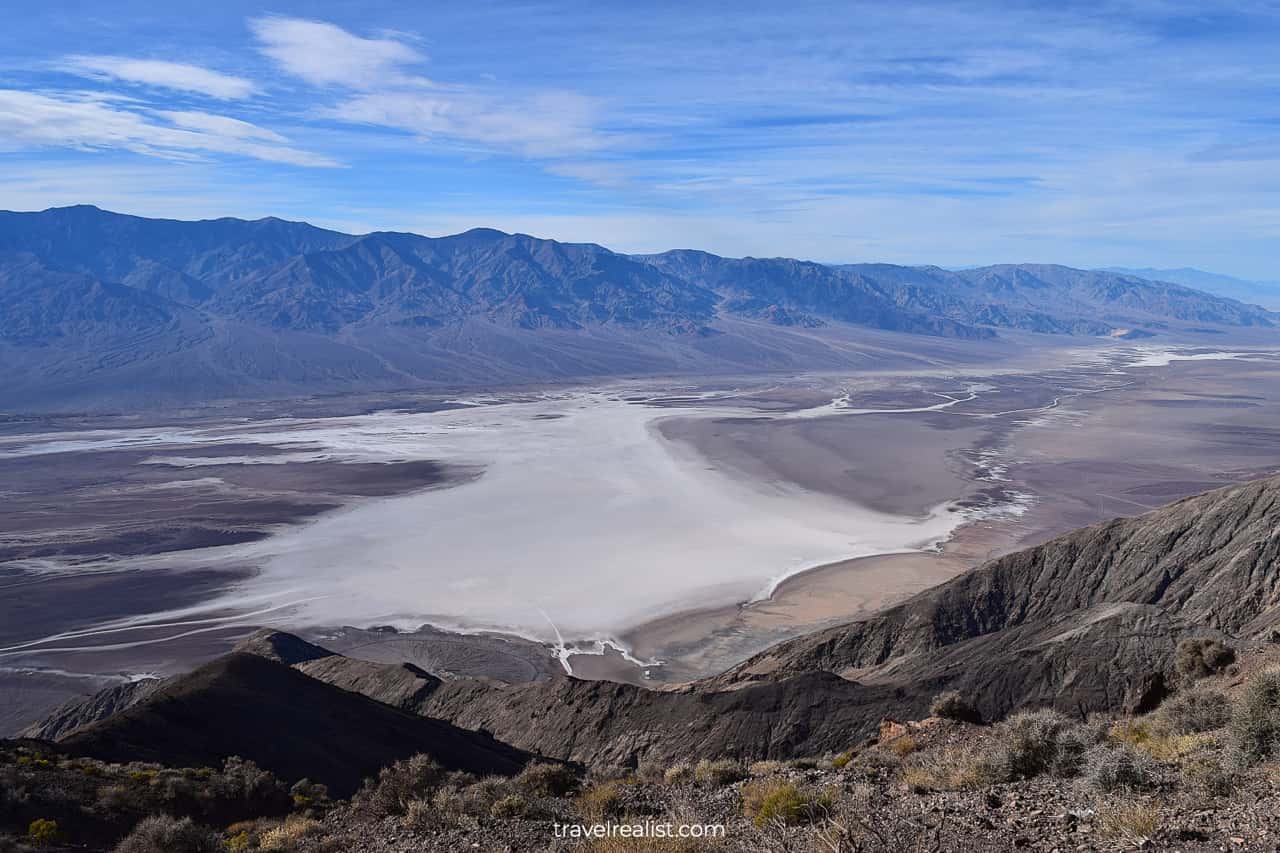
The viewpoint has a short hike from the parking lot if you would like to explore this area further. There is also a way to extend your exploration for a few hours.
This viewpoint is also a starting point of the hike to Mount Perry. This is a 9-mi (14-km) strenuous route. It will take you about 4 to 6 hours to cover this distance. You will gain another 2,090 ft (637 m) on this hike.
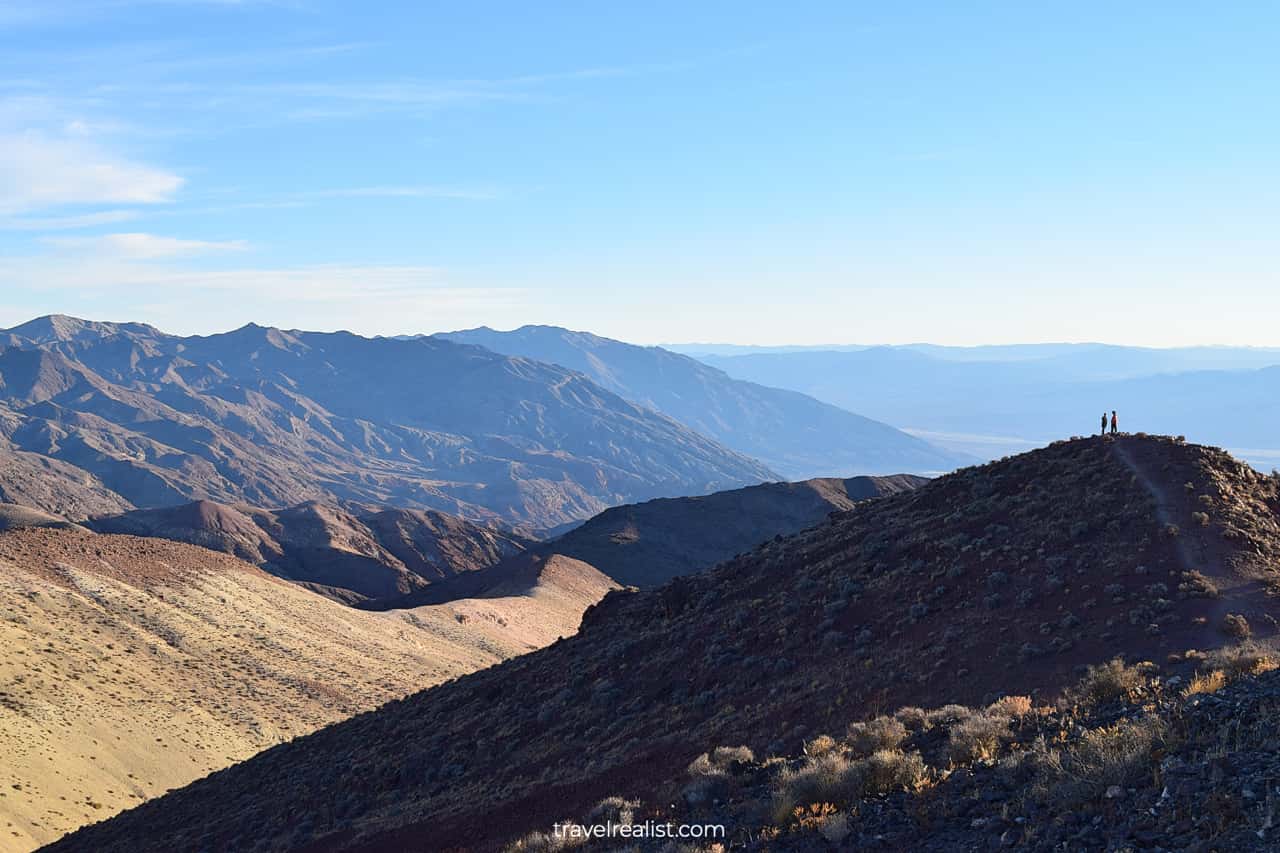
Continue with our Death Valley National Park Guide. You will learn more about ways to get to the sights, entrance requirements, and places to stay.
Getting to Death Valley
Death Valley National Park is in Eastern California along the Nevada state line. A small section of the park stretches over the state line into Nevada.
This section lacks major sights. But Las Vegas is by far the closest major city to Death Valley. It is largest hub to fly into if you visit the park.
It takes about 2 hours to reach the park from Vegas. This driving time compares favorably to a drive from Los Angeles. You would need about 4 hours to reach Death Valley from LA.
Death Valley National Park has 5 paved roads leading into the park.
- Most visitors enter the park from Death Valley Junction, CA via State Highway CA-190. This is the closest entrance to Las Vegas.
- Paramint Springs is the second most popular entrance. It is closest to Ridgecrest and Los Angeles.
- The other three entrances are more remote. Two of them are in Nevada and one in California.
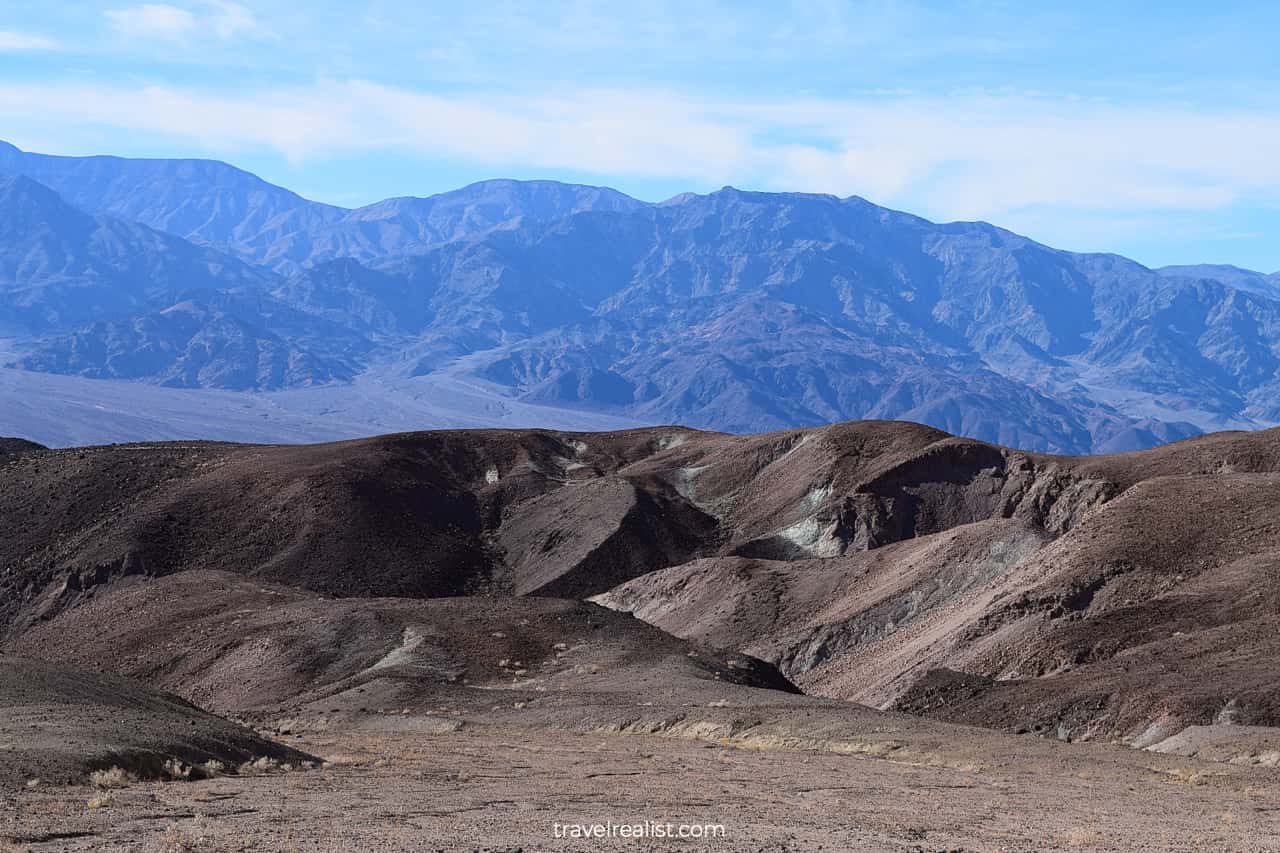
The location of the park entrances allows you to customize your exploration. You can pick and choose the sights to visit that fit with your itinerary.
- You could visit Dantes View first and then proceed to Badwater Basin.
- You could start from Badwater and Zabriskie Point.
- Or you could stop at Mesquite Sand Dunes and Salt Creek first.
Where to Stay near Death Valley
Death Valley National Park is in a very remote part of California. The location of the park makes finding a place to stay a real challenge.
There are very few hotels near the park. In fact, you have the best chances of finding a place to stay in Ridgecrest, CA and Las Vegas, NV. These are the closest destinations to Death Valley that offer you some variety in places to stay.
The former town is about 30 minutes closer to the park entrance. But most hotels in Ridgecrest charge a premium for this location.
On the other hand, Vegas balances a longer drive with more options. No matter where you stay, your drive to Death Valley will likely be quite long. Load up on snacks and podcasts.
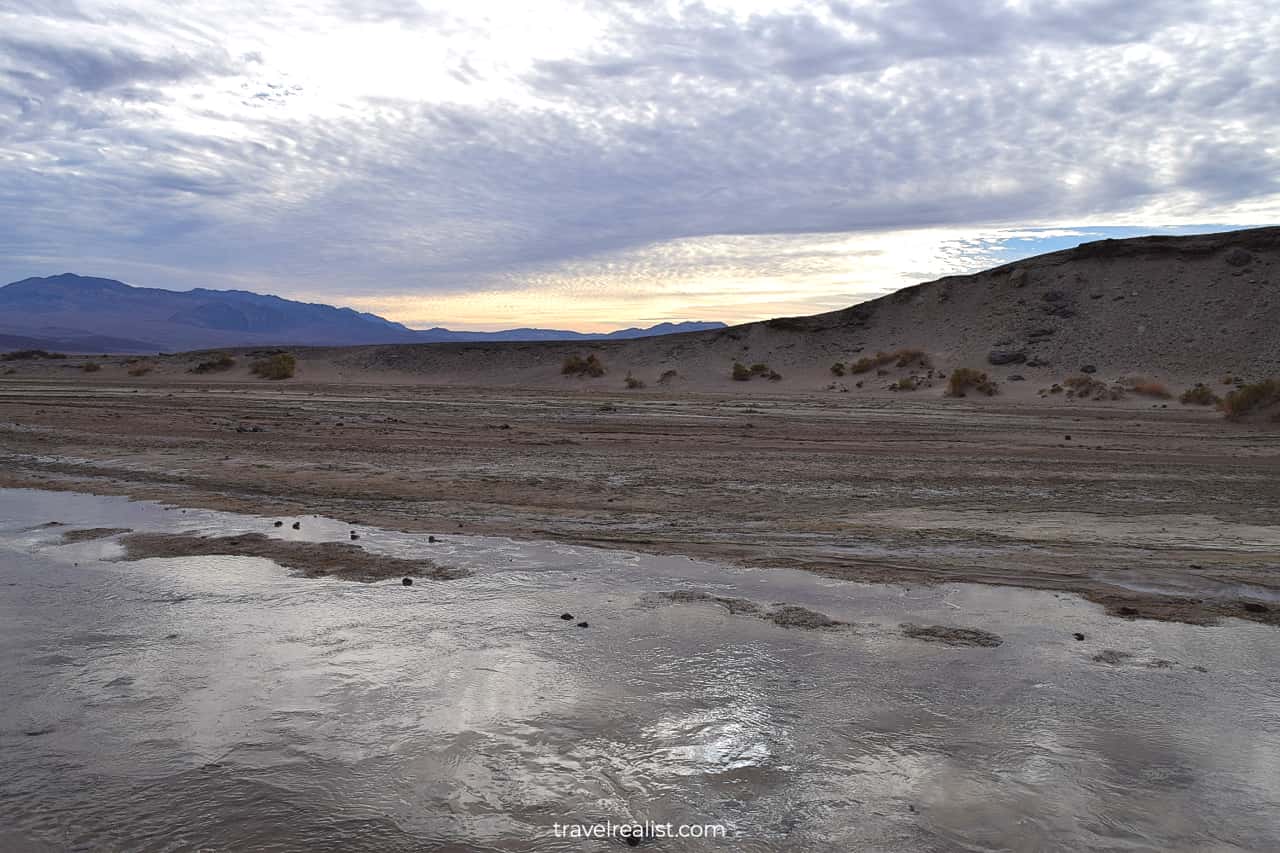
Entrance Requirements & Passes
Death Valley National Park is open 24 hours 365 days a year. The park remains open during the national holidays.
But the visitor centers and ranger stations are closed then. Keep this in mind if you rely on ranger advice when planning your visit to the park.
The park’s climate is very dry with minimal precipitation. You can count on catching sunny weather during your visit.
Death Valley charges admission fees of $30 per car. America the Beautiful annual pass will provide free admission to you and your companions.
Takeaways: Death Valley
Death Valley National Park is a surprisingly versatile park. It might not appear lively at the first glance. But the park is quite rich in wildlife. Death Valley also has plenty to offer in term of sights.
There are lots of highlights of this national park. Make sure to stop at Badwater Basin, Devils Golf Course, Artists Drive, Mesquite Flat Sand Dunes, and Dantes View.
Take a look at our Death Valley National Park Video Guide. And visit our YouTube channel for the latest videos.
Frequently Asked Questions
Death Valley is home to the lowest point in North America. The park also has salt water creeks, colorful formations, and sand dunes.
Death Valley National Park has a lot of sights and places of interest.
– Stop by Badwater Basin, the lowest point in North America.
– Search for salt crystals at Devils Golf Course.
– Drive on the winding Artists Drive to Artists Palette.
– Walk on Mesquite Flat Sand Dunes.
– Admire colorful formations at Zabriskie Point, Mustard Canyon, and Golden Canyon.
– Enjoy a bird’s eye view of Death Valley at Dantes View.
Death Valley National Park is open year round 24 hours a day. You would need to pay entrance fees of $30 per car to drive through Death Valley.
Death Valley National Park is an excellent destination in winter and spring.
Tatooine scenes in Episode IV and V of the Star Wars universe were filmed in Death Valley National Park.
The summer temperature in Death Valley could exceed 120°F (48.9 °C).
There are few hotels near Death Valley. You have the best chance of getting a nearby place to stay in Ridgecrest.
This town is 1.5 hours from the park. Las Vegas, NV is your best option if you do not mind a longer drive. The Sin City has lots of places to stay.
Death Valley National Park is a unique park in the American Southwest. Do not miss a chance to see the lowest point in North America.
Safe realist travels!

